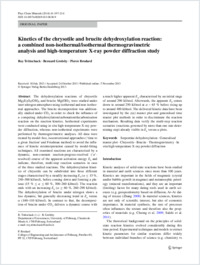Kinetics of the chrysotile and brucite dehydroxylation reaction: a combined non-isothermal/isothermal thermogravimetric analysis and high-temperature X-ray powder diffraction study
- Trittschack, Roy Department of Geosciences, University of Fribourg, Switzerland
- Grobéty, Bernard Department of Geosciences, University of Fribourg, Switzerland
- Brodard, Pierre College of Engineering and Architecture of Fribourg, Switzerland
-
01.03.2014
Published in:
- Physics and Chemistry of Minerals. - 2014, vol. 41, no. 3, p. 197–214
Serpentine dehydroxylation
Generalised master plot
Chrysotile
Brucite
Thermogravimetry
In situ high temperature
X ray powder diffraction
English
The dehydroxylation reactions of chrysotile Mg₃Si₂O₅(OH)₄ and brucite Mg(OH)₂ were studied under inert nitrogen atmosphere using isothermal and non-isothermal approaches. The brucite decomposition was additionally studied under CO₂ in order to check the influence of a competing dehydroxylation/carbonation/decarbonisation reaction on the reaction kinetics. Isothermal experiments were conducted using in situ high-temperature X-ray powder diffraction, whereas non-isothermal experiments were performed by thermogravimetric analyses. All data were treated by model-free, isoconversional approaches (‘time to a given fraction’ and Friedman method) to avoid the influence of kinetic misinterpretation caused by model-fitting techniques. All examined reactions are characterised by a dynamic, non-constant reaction-progress- resolved (‘α’-resolved) course of the apparent activation energy E a and indicate, therefore, multi-step reaction scenarios in case of the three studied reactions. The dehydroxylation kinetics of chrysotile can be subdivided into three different stages characterised by a steadily increasing E a (α ≤ 15 %, 240–300 kJ/mol), before coming down and forming a plateau (15 % ≤ α ≤ 60 %, 300–260 kJ/mol). The reaction ends with an increasing E a (α ≥ 60 %, 260–290 kJ/mol). The dehydroxylation of brucite under nitrogen shows a less dynamic, but generally decreasing trend in E a versus α (160–110 kJ/mol). In contrast to that, the decomposition of brucite under CO₂ delivers a dynamic course with a much higher apparent E a characterised by an initial stage of around 290 kJ/mol. Afterwards, the apparent E a comes down to around 250 kJ/mol at α ~ 65 % before rising up to around 400 kJ/mol. The delivered kinetic data have been investigated by the z(α) master plot and generalised time master plot methods in order to discriminate the reaction mechanism. Resulting data verify the multi-step reaction scenarios (reactions governed by more than one rate-determining step) already visible in E a versus α plots
- Faculty
- Faculté des sciences et de médecine
- Department
- Département de Géosciences
- Language
-
- English
- Classification
- Mineralogy
- License
- License undefined
- Identifiers
-
- RERO DOC 209326
- DOI 10.1007/s00269-013-0638-9
- Persistent URL
- https://folia.unifr.ch/unifr/documents/303472
Statistics
Document views: 74
File downloads:
- Phys_Chem_Minerals_2014_.pdf: 205
